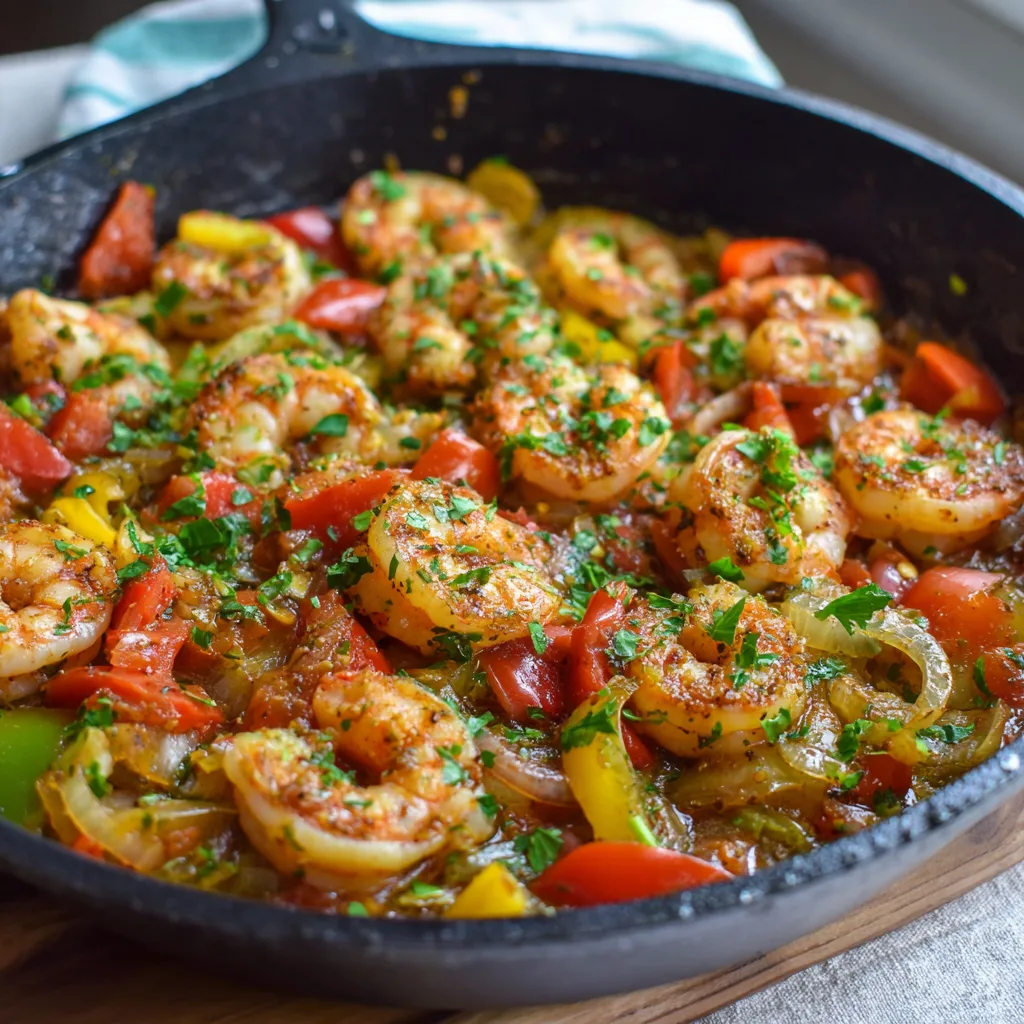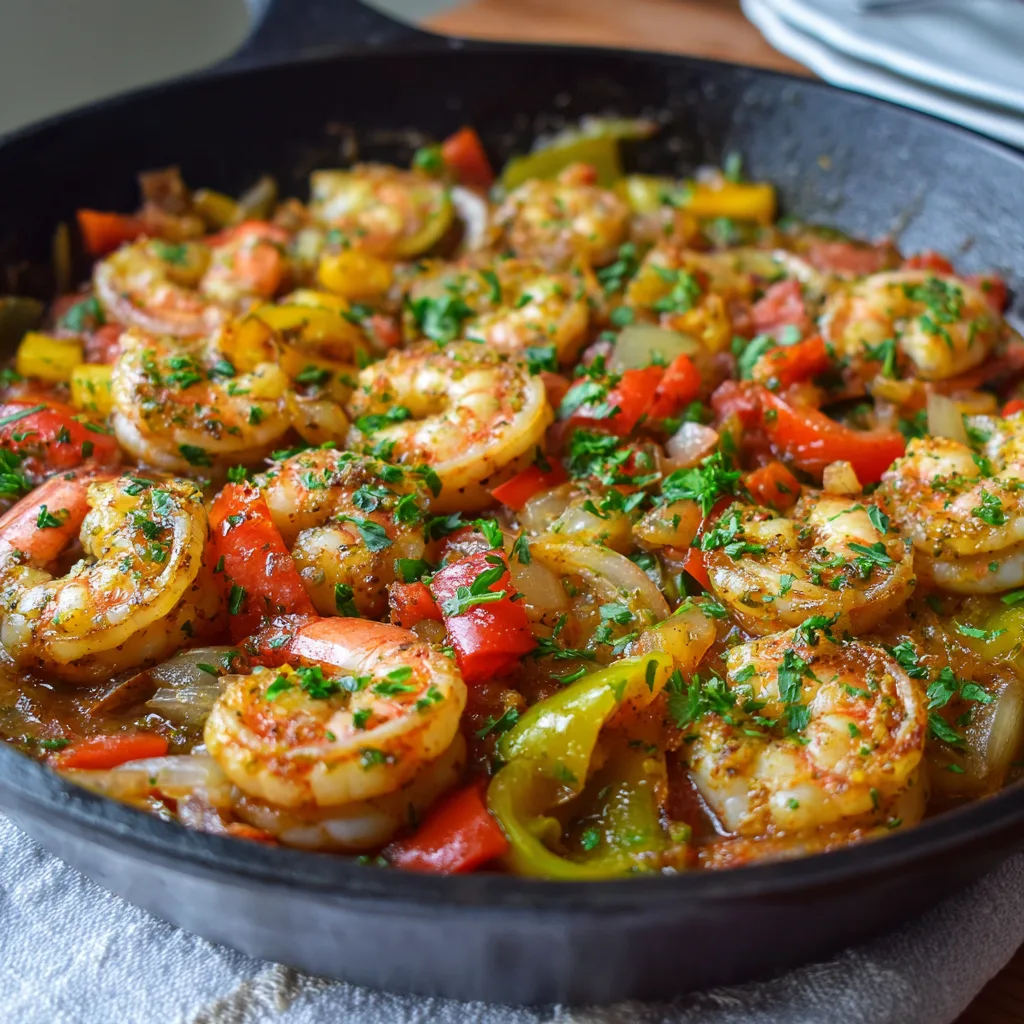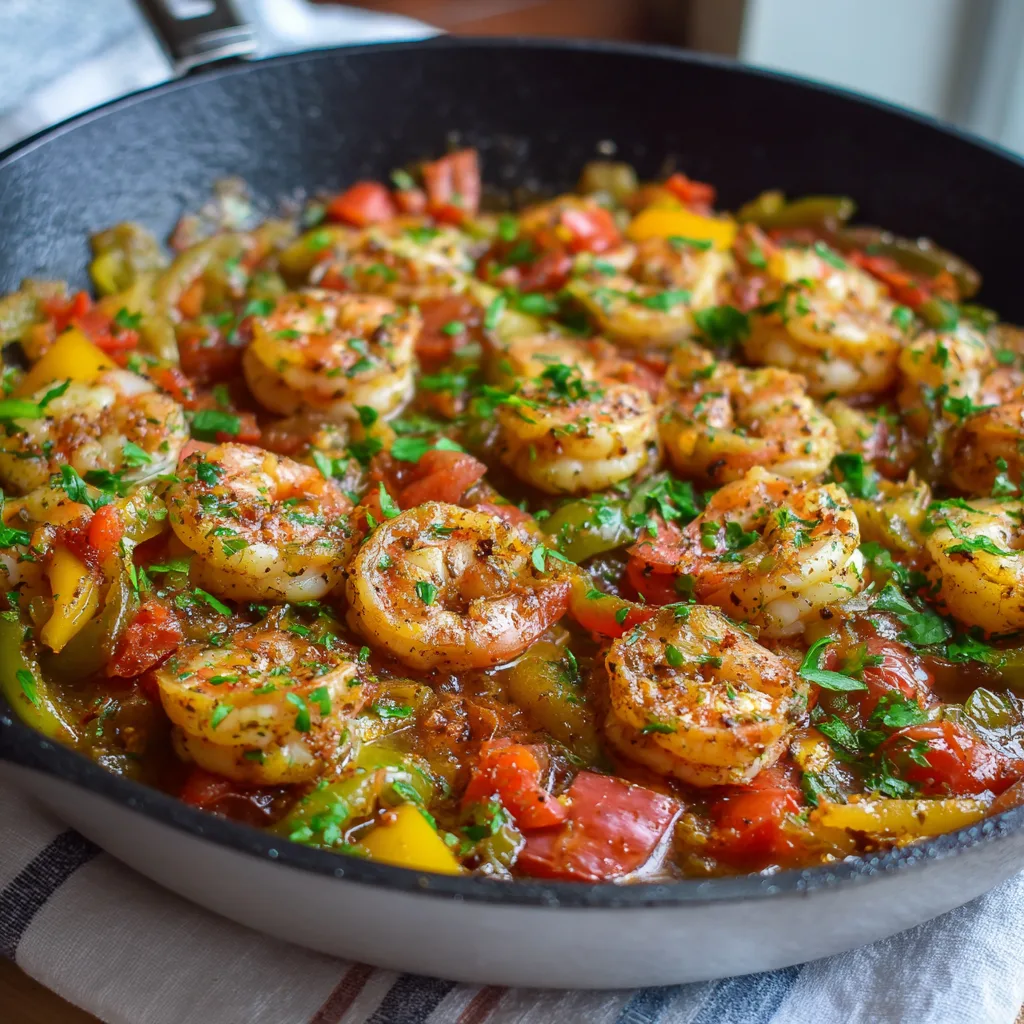What Is an Easy Low Carb Shrimp Skillet?
Shrimp stands out as a lean protein, offering a delicate texture and a subtle, natural sweetness. Packed with essential nutrients like vitamin B12, iodine, and omega-3 fatty acids, it fuels the body without adding excess calories. Its quick-cooking nature makes shrimp ideal for fast, satisfying meals that don’t compromise on taste or nutrition.
Low-carb diets focus on reducing refined carbohydrates while emphasizing protein and healthy fats. This approach supports weight management, stabilizes blood sugar levels, and promotes heart health. People following keto, paleo, or general low-carb plans find shrimp an excellent option, as it complements a variety of vegetables and flavor profiles while keeping carbohydrate intake minimal.
A one-pan shrimp skillet combines convenience and flavor. By cooking shrimp with vegetables and seasonings in a single skillet, you save time on preparation and cleanup. This method locks in moisture and flavor while allowing ingredients to meld beautifully. Each bite delivers a balance of protein, healthy fats, and low-carb vegetables, making it a satisfying, nutritious choice for lunch or dinner. The simplicity of this approach also invites creativity, letting home cooks adjust spices, herbs, and vegetables according to taste preferences.
Why Choose a Low Carb Shrimp Skillet?
A low-carb shrimp skillet promotes health while fitting into busy lifestyles. Its high protein content helps manage weight by keeping you full longer. Shrimp is low in calories yet rich in nutrients, making it heart-healthy and excellent for blood sugar control.
Time efficiency makes this skillet appealing. From prep to plate, meals can be ready in under 30 minutes. Minimal cleanup ensures more time enjoying food rather than scrubbing dishes.
Versatility is another key advantage. You can customize vegetables, seasonings, and cooking styles to suit keto, paleo, or gluten-free diets. This flexibility allows the dish to remain exciting while fitting various dietary needs. Whether served over cauliflower rice, sautéed greens, or alongside a simple salad, a low-carb shrimp skillet is both adaptable and satisfying.
Core Ingredients for a Low Carb Shrimp Skillet
The foundation of any flavorful low-carb shrimp skillet begins with shrimp. Choose large, fresh, or properly thawed shrimp for the best texture. Deveining and peeling ensures a clean, tender bite. Shrimp delivers high-quality protein, low fat, and essential nutrients like selenium and vitamin B12, making it a powerhouse for healthy meals.
Healthy fats enhance both flavor and satiety. Olive oil or butter creates a rich base for sautéing shrimp and vegetables. Olive oil provides heart-healthy monounsaturated fats, while butter adds a creamy, indulgent taste. These fats help absorb fat-soluble vitamins from the vegetables and contribute to the skillet’s satisfying mouthfeel.
Low-carb vegetables are essential for volume and nutrition. Zucchini, bell peppers, and spinach cook quickly and complement shrimp’s delicate flavor. Zucchini adds a mild sweetness, bell peppers provide crunch and color, and spinach contributes iron, fiber, and antioxidants. Combining these vegetables ensures a vibrant, nutrient-dense dish that stays within low-carb limits.
Flavor Enhancers to Elevate Your Skillet
Garlic and onions are classic aromatics that add depth and richness. Sautéed just until fragrant, they release natural sugars that boost overall flavor. Their antioxidant properties also contribute to a healthier meal.
Herbs and spices amplify taste without adding carbs. Italian seasoning, paprika, and Cajun spice blends create bold, layered flavors. Paprika offers a mild smokiness, while Cajun spices provide warmth and complexity. Fresh or dried herbs like parsley, thyme, or oregano enhance aroma and add a colorful finishing touch.
Optional ingredients can add richness and variation. A sprinkle of cheese, a splash of cream, or a bit of broth can transform the skillet into a creamier, more indulgent dish. These elements balance textures and deepen flavors while keeping the meal low in carbohydrates.
Nutritional Considerations
A low-carb shrimp skillet is naturally light yet nutrient-dense. Each serving typically contains under 10 grams of carbohydrates, high protein, and moderate healthy fats, making it ideal for weight management and energy maintenance. Compared to traditional shrimp dishes with rice or pasta, this skillet reduces carbs without sacrificing flavor or satisfaction.
Customizing the dish is easy. Swap vegetables based on seasonal availability or personal preference, adjust spices for intensity, and incorporate alternative fats for dietary needs. These tweaks allow anyone to enjoy a satisfying, balanced, and low-carb meal without compromising taste or nutrition.
Preparation: Getting Ingredients Ready for a Low Carb Shrimp Skillet
Proper preparation sets the stage for a flawless shrimp skillet. Begin by defrosting frozen shrimp in a cold water bath for about 15 minutes. Once thawed, peel and devein each shrimp to ensure tender bites without any grit. Pat them dry to achieve a perfect sear during cooking.
Vegetable prep is equally important. Slice zucchini into even rounds, chop bell peppers into uniform pieces, and roughly chop spinach or leafy greens. Consistent sizes allow vegetables to cook evenly, preventing some from becoming mushy while others stay undercooked.
Organize your spices and seasonings before turning on the stove. Measure garlic, onion, paprika, Italian seasoning, and any optional Cajun spices. Prepping ingredients in advance keeps the cooking process smooth and ensures no flavor element is forgotten.
Cooking Process: Bringing Your Skillet to Life
Start by heating olive oil or butter in a large skillet over medium heat. Once shimmering, add shrimp in a single layer. Sauté for 2–3 minutes per side, just until pink and opaque. Avoid overcrowding the pan to maintain a proper sear and retain moisture inside the shrimp.
Remove the shrimp and set aside. In the same skillet, add vegetables beginning with bell peppers and onions. Sauté for 4–5 minutes until they soften but remain crisp. Add zucchini last, as it cooks faster, ensuring it retains its texture. Stir occasionally for even cooking without over-softening.
Once vegetables are nearly tender, return shrimp to the pan. Mix gently to combine flavors and coat the ingredients with any remaining oil or butter. Layering shrimp over vegetables allows flavors to meld while keeping each component distinct. For extra depth, sprinkle in a small splash of broth or a touch of cream, stirring lightly to integrate.
Final Touches: Enhancing Flavor and Presentation
Taste the skillet and adjust seasoning with salt, pepper, or additional spices. A well-balanced skillet should have bright, savory, and slightly sweet notes from vegetables and shrimp.
Garnish with freshly chopped parsley or a few sprigs of thyme to elevate presentation. Colorful garnishes make the dish visually appealing while adding subtle herbal notes.
Serve your shrimp skillet as a standalone low-carb meal or pair it with cauliflower rice, sautéed greens, or a simple leafy salad. These sides maintain the low-carb focus while complementing the skillet’s rich flavors. The dish is ready in under 30 minutes, making it perfect for busy weeknights or quick, healthy lunches.
Flavor Profiles: Exciting Twists on Your Shrimp Skillet
A low-carb shrimp skillet adapts easily to bold flavors. For a Cajun-style twist, add smoked sausage, bell peppers, and a touch of paprika or Cajun seasoning. This creates a smoky, slightly spicy dish with rich, layered flavors.
Tuscan-inspired versions focus on fresh vegetables and creamy textures. Incorporate spinach, diced tomatoes, and a light garlic cream sauce. The result is a savory, aromatic skillet with vibrant colors and a balanced, indulgent taste without excess carbs.
For a Mediterranean flair, feature olives, crumbled feta, and oregano. Add a squeeze of lemon to brighten the dish. This variation emphasizes tangy and herbal notes while keeping the skillet light, nutritious, and satisfying.
Dietary Adaptations: Making the Skillet Fit Your Lifestyle
Keto-friendly modifications are simple. Adjust fat content by adding butter or olive oil, and keep carbohydrate sources limited to low-carb vegetables. This ensures the skillet aligns with ketogenic macros while remaining flavorful.
Paleo adaptations focus on whole, unprocessed ingredients. Eliminate dairy and cream, using coconut milk or almond-based alternatives for richness. Fresh vegetables and spices maintain the dish’s satisfying texture and taste.
Gluten-free options require careful ingredient selection. Use naturally gluten-free spices, oils, and seasonings. Most vegetables and shrimp are already gluten-free, so the main consideration is any added sauces or broth. This ensures a safe, low-carb meal suitable for all dietary needs.
Ingredient Substitutions: Flexibility Without Compromise
Shrimp can be swapped for other proteins without losing flavor. Scallops, chicken breast, or firm tofu provide high protein and pair well with the skillet’s vegetables and spices.
Vegetable swaps allow variety and seasonal adaptation. Use cauliflower rice in place of traditional grains to maintain a low-carb profile. Other options include zucchini noodles, asparagus, or mushrooms, depending on texture preference.
Dairy-free alternatives broaden the dish’s accessibility. Coconut milk, almond cream, or non-dairy cheese can replace butter, cream, or traditional cheese. These swaps preserve richness while keeping the dish light, nutritious, and low in carbs.
Common Inquiries About Low Carb Shrimp Skillet
What makes a shrimp skillet low-carb?
A shrimp skillet stays low-carb by focusing on protein-rich shrimp and non-starchy vegetables. Avoiding grains, potatoes, or sugary sauces keeps carbohydrate content minimal while maintaining flavor and nutrition.
Can I use frozen shrimp?
Yes, frozen shrimp works well. Thaw them in cold water and pat dry before cooking. Properly thawed shrimp sears perfectly, retaining tenderness and absorbing seasonings efficiently.
How can I make the dish spicier?
Add heat using red pepper flakes, cayenne, or a low-carb hot sauce. Adjust gradually, tasting as you go to maintain a balanced flavor without overwhelming the dish.
Can I prepare this dish in advance?
Absolutely. Cook shrimp and vegetables separately, then store in an airtight container in the refrigerator for up to two days. Reheat gently in a skillet to prevent overcooking the shrimp.
What are some side dishes that pair well with a shrimp skillet?
Low-carb sides complement the skillet without adding unnecessary carbs. Cauliflower rice, sautéed spinach, zucchini noodles, or a fresh leafy salad provide balance while enhancing the meal’s nutritional profile. These options keep the dish satisfying and complete for lunch or dinner.




